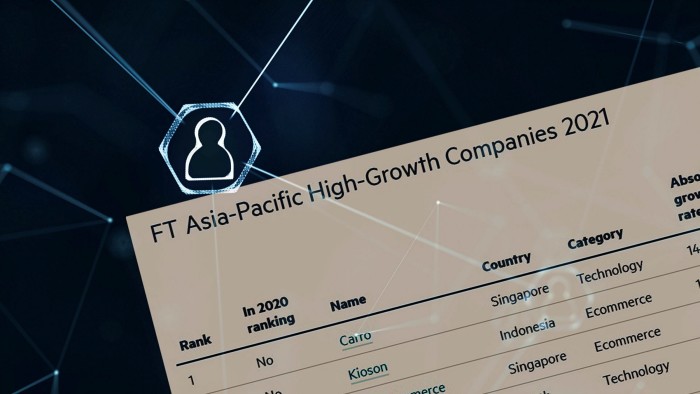FT ranking: Asia-Pacific High-Growth Companies 2021

Simply sign up to the Asia-Pacific companies myFT Digest -- delivered directly to your inbox.
Asia-Pacific has been one of the first regions to emerge from the Covid-19 pandemic, but the IMF fears the damage will leave deep scars on some economies that will take several years to heal.
National lockdowns and the stalling of business activity have amplified existing problems in certain countries: worsening inequality, adding to unemployment and exposing gaps in social welfare. For the region’s companies, however, a higher debt burden and a reduction in the earnings to service it, pose a more immediate threat.
Earlier this month, the IMF said: “Government support is helping them to keep afloat, but a large wave of corporate bankruptcies could follow when that support is withdrawn . . . This vulnerability can be especially acute in Asia, if global financial market conditions tighten in the process of recovery, leading to capital outflows and additional pressure on the corporate sector.”
This latest annual FT ranking of 500 of the region’s high-growth companies — compiled in partnership with Nikkei Asia and research provider Statista — therefore comes at a time of peak risk. The figures in the table below do not show how these businesses have fared over the past year, but they do identify those that were in a position of strength coming into the crisis.
Whether this gives them enough momentum or resilience to survive — or, in the case of some tech start-ups, to thrive — will be further explored in a special report to be published on April 15.
Companies in the FT Asia-Pacific list ranks entrants from across the region by their compound annual growth rate (CAGR) in revenue between 2016 and 2019. (China has been omitted due to difficulties in verifying data.)
Technology is the sector with the biggest presence on the ranking, with a quarter of all companies falling into this category. It is followed by support services and industrial goods, each accounting for just over 4 per cent of those businesses listed.
The top three on the list are a Singapore-based online marketplace for used cars, an Indonesian digital payments platform and a Singaporean provider of ecommerce sites — all of which have a 2016-19 CAGR above 320 per cent.
But the top 20 companies are from a broad mix of sectors beyond technology, including energy, financial services and transport.
Read the full report and in-depth analysis of the ranking here
With 116 companies, Japan has the most entries on the list, overtaking India, last year’s leader, which is home to 95 of the companies. Singapore comes in third place with 72. The top three cities remain the same as last year, but with Tokyo edging ahead of Singapore, by 82 companies to 72, and Sydney having 27 companies in the ranking.
A ranking such as this can never claim to be complete, though, as many fast-growing companies are privately held and detailed financial information is not made public. Also, some companies in the region did not want to reveal their revenue figures, or chose to not take part for other reasons.
Of those that did disclose and verify their revenues, the 500 fastest-growing are sorted in the table here. Readers can use the toggles at the top of the table’s columns to filter by country, sector or revenue.
See the full methodology below the table.
This table has been amended since publication to reflect new information
Methodology
The FT Asia-Pacific High Growth Companies 2021 ranking is a list of 500 companies in the Asia-Pacific region that have achieved the highest compound annual growth in revenues between 2016 and 2019. The ranking was created through a complex procedure. Although the search was very extensive, the ranking does not claim to be complete, as some companies did not want to make their figures public or did not participate for other reasons.
Through research in company databases and other public sources, Statista identified tens of thousands of companies in the Asia-Pacific region as potential candidates for the ranking. These businesses were invited to participate in the competition by post, email and telephone.
The project was also advertised online and in print, allowing all eligible companies to register via the websites created by Statista and the Financial Times. In addition, Statista researched exchange-listed high profile companies from Taiwan to make the list more comprehensive.
Criteria for inclusion
To be included in the list of fast-growing companies in the Asia-Pacific region, a company had to meet the following criteria:
Revenue of at least $100,000 generated in 2016 (or currency value equivalent as of December 31 2016);
Revenue of at least $1m generated in 2019 (or currency value equivalent as of December 31 2019);
An independent company (not a subsidiary or branch office of any kind);
Headquartered in one of these 13 territories in the Asia-Pacific region – Australia, Hong Kong, India, Indonesia, Japan, Malaysia, New Zealand, Philippines, Singapore, South Korea, Taiwan, Thailand and Vietnam;
Revenue growth between 2016 and 2019 that was primarily organic (ie “internally” generated).
Calculation of growth rates
The calculation of growth rates is based on the revenue figures submitted by the companies in their respective national currency. For better comparability in the ranking, the revenues were converted into US dollars. The exchange rates of December 31 2016 and 2019, respectively, were used for this purpose.
The compound annual growth rate (CAGR) was calculated as follows:
((revenue2019 / revenue2016 )^(1/3)) — 1 = CAGR
The absolute growth between 2016 and 2019 was calculated as follows:
(revenue2019 / revenue2016) — 1 = Growth rate
Evaluation and quality assurance
All data reported by the companies was processed and checked by Statista. Missing data entries (employee numbers, address data, etc) were researched in detail. Companies that did not fulfil the criteria for inclusion in the ranking were deleted.
The minimum average growth rate required to be included in the ranking this year was 8.9 per cent.
Comments